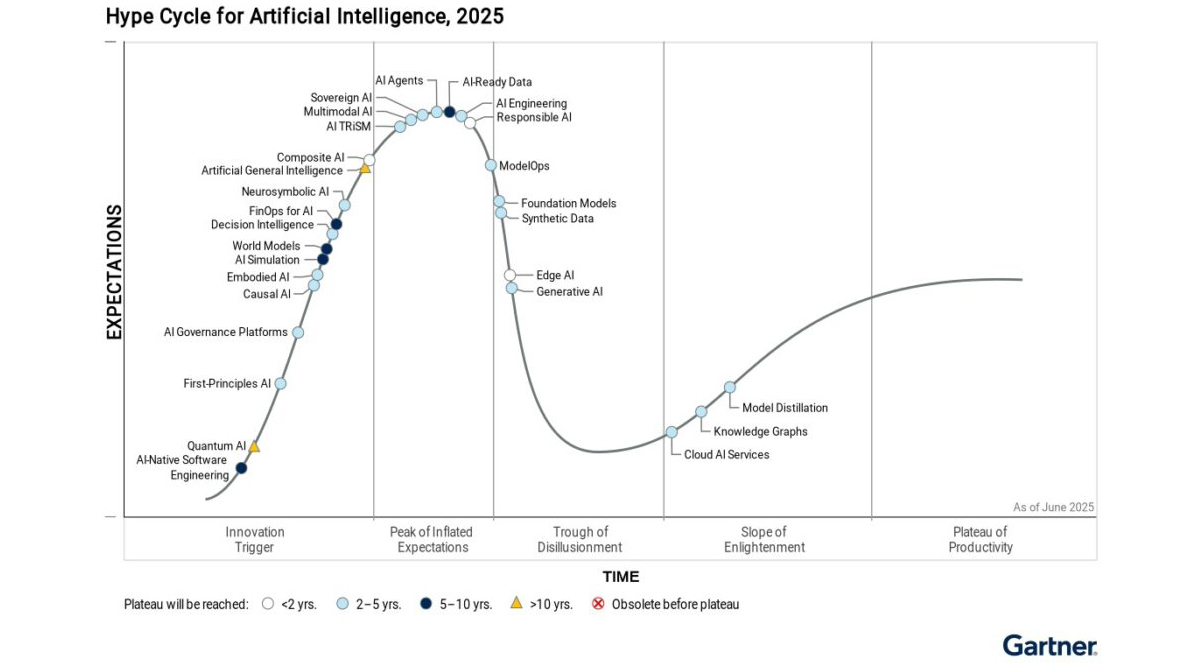The artificial intelligence bubble is deflating. According to The Economist, Western tech firms driving the AI revolution have seen their share prices drop by 10% since last month. The Census Bureau reports that only 5.1% of American companies actively use AI in production—down from 5.4% earlier this year. For those watching from the sidelines, this might seem like vindication. For those who've been in the trenches, it's an entirely different story.

The Inevitable Journey Through Disillusionment
Gartner's 2025 Hype Cycle for AI confirms what many of us suspected: while GenAI grabbed headlines, the real action has shifted to foundational innovations like AI engineering and ModelOps. This isn't retreat—it's maturation. The technology world has seen this pattern before with railways, the internet, and cloud computing. But AI's journey through the hype cycle carries unique implications for professional services, particularly in law.
The numbers paint a sobering picture. A recent RAND Corporation report revealed that 80% of AI projects fail—twice the rate of other IT projects. In the legal sector specifically, the challenges are even more pronounced. Trust, accuracy, and professional liability create additional layers of complexity that consumer-facing AI applications simply don't face.
Yet dismissing these "failures" as wasted investment fundamentally misunderstands how technological transformation works in regulated industries.
Legal's Unique Position in the AI Landscape
The legal industry's relationship with AI differs markedly from other sectors. While 64% of legal departments using AI focus on contract-related tasks, with 49% leveraging it for legal research, the real story lies beneath these statistics. Unlike retail or manufacturing, where AI often replaces human tasks wholesale, legal AI augments expert judgment in ways that require deep domain knowledge to implement effectively.
Consider the transformative potential in transactional law. Firms report productivity gains exceeding 100x in high-volume litigation matters, with complaint response times dropping from 16 hours to 3-4 minutes. But achieving these gains requires more than purchasing software—it demands fundamental rethinking of workflows, quality control, and client delivery models.
This is particularly relevant in markets like Denmark, where high digitalization rates and sophisticated corporate clients create both opportunity and expectation. The Nordic legal market's embrace of technology, exemplified by collaborations between firms like Dentons and AI providers like Legora, signals a regional commitment to innovation that goes beyond mere experimentation.
The Hidden Assets of Early Adoption
Infrastructure That Can't Be Bought
When firms rushed to implement AI in 2023 and early 2024, many focused on visible outputs—chatbots, document automation, research tools. What they actually built was far more valuable: the invisible infrastructure of AI readiness.
As Gartner notes, "most organisations lack the data, analytics and software foundations to move individual AI projects to production at scale". Early adopters have spent the past two years addressing exactly these foundational challenges:
- Data Governance Frameworks: Establishing protocols for data quality, access controls, and ethical use—essential for client confidentiality and regulatory compliance
- API Integrations: Building connections between AI tools and existing practice management systems, document repositories, and knowledge bases
- Security Architecture: Developing approaches to AI that satisfy both innovation needs and professional obligations
Organizational Learning That Compounds
Beyond technical infrastructure lies something even more valuable: organizational learning. Every "failed" pilot taught lessons about change management, user adoption, and the critical difference between technological possibility and practical utility.
Mid-sized law firms now report 40-60% time savings on standard contracts, correspondence, and discovery responses. But reaching this efficiency required months of iteration, training, and process refinement—experience that late adopters must now acquire while early movers accelerate ahead.
The teams that struggled through early implementations have developed what might be called "AI intuition"—the ability to quickly assess which use cases will deliver value versus those that merely demonstrate capability. This discrimination becomes crucial as AI vendors proliferate and promised capabilities increasingly diverge from practical outcomes.
Client Trust and Market Positioning
Perhaps most critically, early adopters have navigated the delicate process of introducing AI into client relationships. Research shows that 70% of businesses now prefer working with law firms that utilize AI, but this preference comes with expectations of transparency, security, and maintained quality.
Firms that began this journey two years ago have already worked through initial client concerns, established communication protocols, and demonstrated value through successful implementations. They've learned which clients embrace AI-enhanced services and which require more traditional approaches—market intelligence that can't be acquired quickly.
From Experimentation to Value Creation
The Shift to Production Mindset
The current "trough of disillusionment" marks a critical transition point. As organizations move from passive AI chatbots toward agentic AI systems, the focus shifts fundamentally from what's possible to what's valuable. This evolution demands new approaches to program management and value realization.
Successful firms are adopting structured portfolio management approaches, treating AI initiatives not as isolated experiments but as coordinated programs with clear business objectives. This includes:
- Value-Driven Prioritization: Scoring potential use cases on ROI matrices that balance implementation complexity against business impact
- Staged Implementation: Moving from high-confidence, low-risk applications to more transformative but complex use cases
- Continuous Measurement: Establishing KPIs that track not just efficiency gains but client satisfaction, error rates, and knowledge capture
Business Cases That Resonate
The era of AI for AI's sake has ended. Today's successful implementations start with clear business cases that articulate value in terms clients and partners understand. For transactional practices, compelling use cases emerge in:
Due Diligence Acceleration: AI systems trained on historical transactions can reduce initial document review time by 70-80%, freeing senior resources for strategic analysis rather than procedural review.
Risk Pattern Recognition: Machine learning models can identify clause variations and potential risks across thousands of contracts in minutes—a task that would require weeks of junior associate time.
Knowledge Preservation: AI-powered systems can capture and codify the expertise of senior practitioners, making decades of experience accessible to entire teams.
The Danish Opportunity
The Danish legal market presents unique conditions for AI value realization. High digitalization rates, sophisticated corporate clients, and a cultural openness to innovation create fertile ground for transformation. Combined with strong data protection frameworks and ethical business practices, Denmark offers an ideal environment for responsible AI implementation.
For firms specializing in complex transactions—M&A, private equity, major commercial deals—AI's ability to process vast amounts of information while maintaining accuracy becomes particularly valuable. The technology doesn't replace legal judgment; it amplifies the ability to exercise that judgment across larger deal volumes and tighter timelines.
The Path Forward: Strategic AI Leadership
As we move beyond the hype cycle's trough, success will belong to organizations that approach AI with strategic discipline rather than technological enthusiasm. This requires:
Governance Structures That Enable Scale
Rather than ad-hoc experimentation, leading firms are establishing formal AI governance structures. These typically include:
- Strategic Alignment: Quarterly reviews that ensure AI initiatives support broader firm objectives
- Portfolio Management: Systematic evaluation and prioritization of use cases based on value potential
- Risk Management: Clear frameworks for addressing ethical, security, and professional liability concerns
Investment in Human Capital
While 59% of legal professionals describe themselves as "somewhat familiar" with AI tools, only 24% feel they have strong understanding of AI fundamentals. Closing this knowledge gap requires sustained investment in training, mentorship, and hands-on experience.
Successful programs identify "AI Champions" within practice groups—respected practitioners who can bridge technical capabilities and legal expertise. These champions become crucial for driving adoption and ensuring that AI enhances rather than disrupts established workflows.
Client-Centric Innovation
The most successful AI implementations start with client needs rather than technological capabilities. This means:
- Early client involvement in pilot programs
- Transparent communication about AI use in service delivery
- Continuous feedback loops that refine implementations based on client value perception
Conclusion: The Competitive Moat of Experience
As AI moves from experimental technology to operational necessity, the firms that invested early—despite initial failures and current skepticism—hold decisive advantages. They've built infrastructure, developed expertise, and established client trust that late adopters must now scramble to replicate.
The "trough of disillusionment" isn't a verdict on AI's potential—it's a natural transition from unbounded enthusiasm to practical implementation. For legal services, this transition offers particular opportunity. The complexity of legal work, combined with increasing client demands for efficiency and value, creates compelling use cases for AI augmentation.
The question facing law firms today isn't whether to adopt AI, but how to transform early experiments into sustainable competitive advantage. Those who approach this challenge with strategic discipline, client focus, and commitment to continuous learning will find that today's disillusionment becomes tomorrow's differentiation.
In markets like Denmark, where digital sophistication meets innovative business culture, the opportunity to lead this transformation is particularly pronounced. The firms that seize this moment—building robust AI programs that deliver measurable value—will define the future of legal services not just in their local markets, but globally.
The hype may be fading, but the real work has just begun.

About the Author
Jacob Langvad Nilsson
Jacob Langvad Nilsson is a Digital Transformation Leader with 15+ years of experience orchestrating complex change initiatives. He helps organizations bridge strategy, technology, and people to drive meaningful digital change. With expertise in AI implementation, strategic foresight, and innovation methodologies, Jacob guides global organizations and government agencies through their transformation journeys. His approach combines futures research with practical execution, helping leaders navigate emerging technologies while building adaptive, human-centered organizations. Currently focused on AI adoption strategies and digital innovation, he transforms today's challenges into tomorrow's competitive advantages.
Ready to Transform Your Organization?
Let's discuss how these strategies can be applied to your specific challenges and goals.
Get in touchRelated Insights
Legal Services: From Billable Hours to AI Value
How AI is reshaping legal services by automating routine tasks, enhancing research, and enabling data-driven insights.
AI Knowledge Management: Collective Intelligence
How AI-enabled knowledge management systems capture, organize, and leverage collective intelligence in professional services.